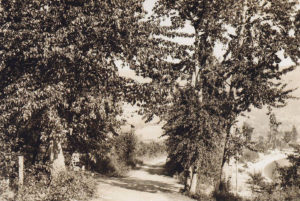“The Railroad” was the name used on the earliest colonial maps, before the settlement in Lake Country, to refer to the isthmus at Oyama. The term certainly did not refer to any European-made feature; it had to refer to either a natural or an Okanagan First Peoples structure. What was it?

Until the late eighteenth century, the Okanagan People hunted and fished over a wide territory, including Okanagan Lake, Kalamalka Lake and Wood Lake. Heavy goods such as loads of dried venison, fish and berries were transported there from as far away as the Coldstream valley and Silver Star mountain. Water transport, using dugout canoes or rafts, was the most efficient means of conducting this long distance transport of bulk goods. Water transport from the Coldstream to the Oyama isthmus was straight forward, but then the canoes and their loads had to be hiked over the isthmus and up four feet in elevation to refloat on Wood (formerly Pelmewash) Lake. We know that the Okanagan people used corduroy rails or logs to bring canoes over the mud on to land at Okanagan Landing, and it is likely that they used a “rail road” as a slip to pass between Kalamalka and Wood lakes as well. The Syilx name for the Oyama isthmus was acyuʔc̕us (Ac yutz oos) meaning a narrow crossing with thickly entwined willows (or anything closely intertwined). “The Railroad” likely referred to a rail (corduroy) road made by the Okanagan people by cutting and laying down closely intertwined poles or willows to facilitate their crossing of the isthmus.







Ian Pooley
Thank you. I’ve wondered for years where the term “Railroad” came from.